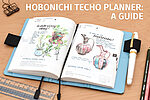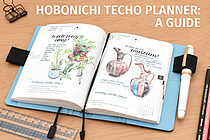| Term | Kanji | Furigana | Definition |
|---|
| Fude | 筆 | ふで | "Fude" (pronounced foo-day) means "brush." This term shows up in the names of many brush pen products, like the Tombow Fudenosuke. |
| Washi | 和紙 | わし | A type of Japanese paper that was historically handmade using plant fibers from mulberry, bamboo, or rice. Washi tapes are made by adding adhesive backing to strips of colorful washi paper. |
| Techō | 手帳 | てちょう | Based on the words for "hand" and "book," "techō" means "pocket notebook" or "planner." The versatile Hobonichi Techo can be used as a planner, journal, and more. |
| Iro | 色 | いろ | "Iro" means color, so it shows up in product names like the luxurious Pilot Iroshizuku Inks. The word "sai" also means color. |
| Gansai | 顔彩 | がんさい | Traditional Japanese watercolors. Gansai watercolors are boldly pigmented and very opaque on paper. |
| Etegami | 絵手紙 | えてがみ | Based on the words for "picture" and "message," etegami is a Japanese folk art involving simple drawings and a brief message. The philosophy of etegami is to be spontaneously thoughtful. It is generally done on postcards, which are easily mailed off to friends. |
| Maki-e | 蒔絵 | まきえ | Maki-e, which means "sprinkled picture," is a Japanese art form that involves carefully sprinkling a lacquered surface with powder made from gold, silver, copper, and other precious metals. The metallic powder is also applied using brushes or sponges to create beautiful motifs. |
| Raden | 螺鈿 | らでん | Raden is a technique in which lacquered wares are inlaid with small fragments of ivory or shell, such as mother-of-pearl or abalone. |
| Shitajiki | 下敷き | したじき | A flat, lightweight plastic board that is placed underneath a sheet of paper. It provides a smooth writing surface and prevents heavy-handed writers from denting or marking the pages underneath. It is also known as a "pencil board" or "writing board." |
| Shikkari | 確り | しっかり | A word that means "tightly" or "securely." The Kokuyo Campus Shikkari paper has more texture, which allows your pen or pencil to grip the paper securely. |
| Sharp | | シャープ | An English word that has taken on separate meaning in the Japanese stationery world. Instead of its literal meaning, "sharp" is another word for a mechanical pencil -- a pencil that is always sharp. |
| Sign Pen | | サインペン | Another English-to-Japanese term, "sign pen" usually refers to felt-tipped writing markers. However, the term can be used for any pen that is intended for writing signatures. |
| Knock | | ノック | The motion of pressing down on a button to extend the pen tip or pencil lead. The push button itself is often called a "knock button". |
| Kuru Toga |
尖る | くるくる
とがる | The Uni Kuru Toga Auto Lead Rotation Mechanical Pencil's name comes from "kurukuru", a mimetic word for the sound of something rotating or spinning, and "togaru," a verb meaning "to taper." |
| Kira | | キラ | "Kirakira" is a mimetic word for something twinkling or sparkling. Some of our metallic and glitter pens have "kira" in their name, like the Sakura Ballsign Kirara. |
| Fureru | 振れる | ふれる | This means to shake. The Pilot Fure Fure Pencils are appropriately named because you extend lead by shaking the pencil back and forth. |
| Sarasara | | さらさら | "Sarasara" is a mimetic word that describes silky-smooth items, such as the smooth-writing Zebra Sarasa Gel Pens. |
| Sharbo | | シャーボ | The customizable Zebra Sharbo Multi Pen gets its name from "Sharp" + ballpoint, due to its ability to hold both ink and pencil refill components. |
| Sumi Ink | 墨 | すみ | Based on the words for "ink" and "water", sumi ink was traditionally made by grinding ink sticks on a palette and then gradually adding water. Today, pre-mixed sumi ink is sold in bottles for convenience. Most sumi inks are water resistant when dry. |
| Mensō | 面相 | めんそう | "Mensō" means "face." A menso brush is a fine-point brush used for intricate detail work like small facial features. |
| Manga | 漫画 | まんが | The art of Japanese comics. Manga works cover many genres (including action, mystery, and romance) and are read by people of all age groups. |
| Mangaka | 漫画家 | まんがか | A manga artist. |
| Diary | | ダイアリー | "Diary" is commonly used instead of planner in Japanese. This is true in British English as well. |
| Free | | フリー | You'll often see Japanese planners labelled as "free". This simply means that the planner is undated. |
| Flake | | フレーク | "Flake" stickers are die-cut stickers |
| Gokuboso | 極細 | ごくぼそ | You'll often see these kanji characters on brush and fountain pens. "極細" means superfine or extra fine. |
| Hosoji | 細字 | ほそじ | "細字" means small type or handwriting. You'll find it on fine brush pens or fountain pen nibs. |
| Chūji | 中字 | ちゅうじ | "中字" refers to medium tips or nibs. |
| Futoji | 太字 | ふとじ | "太字" means boldface or bold-type. This can be found on broad tips or nibs. |

























